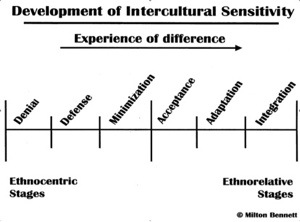Have you already encountered your first intercultural issue during your holidays? Maybe it was in a restaurant where the waiter did not serve you exactly what you wanted; or maybe your neighbours in your holiday resort are awake when you normally sleep and vice versa. How do you deal with these problems? Do you walk away angry, do you change rooms and hope it won’t happen again?
Intercultural competence begins with knowing who you are and being sensitive to your own values and beliefs. What are your triggers and how do you behave? Where does this come from? How open are you to other views, cultures, habits etc.? A good way to start, is the Bennett scale or “Development Model of Intercultural Sensitivity” (DMIS). You can find more info about it here (as I explained it in one of my previous posts). This scale is actually a good starting point to examine where you are so that you can become aware of your own actions/reactions. If you are in one of the ethnocentric stages for example, you will be more likely to think in stereotypes and not be able to appreciate different worldviews as you would feel threatened by these.
I personally always find that Europe during the summer is an excellent place to practice intercultural competence and skills. Why? Many people from different backgrounds are coming together in major touristic hubs so that you can not only hear and listen to many different languages but also observe different cultural behaviours all in one spot. What a great potpourri of people…
By the way: as I am now on wordpress.org and not anymore on wordpress.com, and if you don’t want to follow me with your e-mail address, you can simply click ‘edit’ in your wordpress reader and enter my URL (www.jennyebermann.com) in the text box at the top of the page. All my new posts will start appearing in your reader immediately! Happy reading! Jenny



